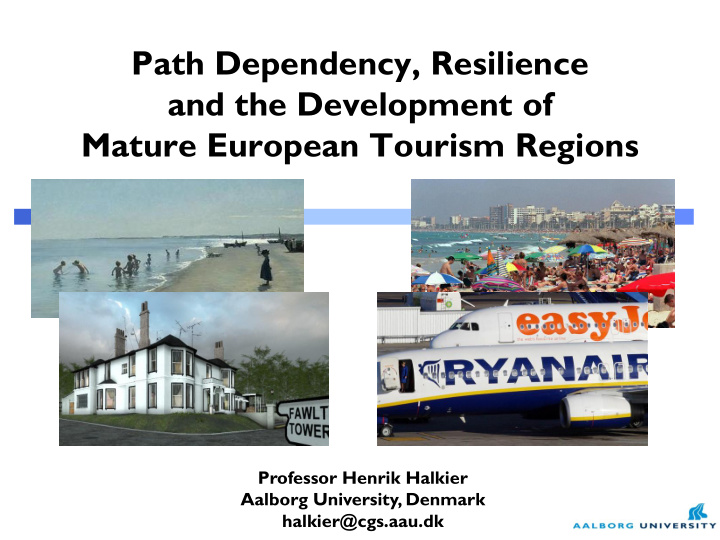



Path Dependency, Resilience and the Development of Mature European Tourism Regions Professor Henrik Halkier Aalborg University, Denmark halkier@cgs.aau.dk
Path Dependency, Resilience and the Development of Mature European Tourism Regions 1. Regions and destinations: Path dependency and resilience 2. Reconceptualising tourism regions 3. Maturity and resilience? The case of North Jutland, Denmark 4. Conclusions and perspectives Professor Henrik Halkier Aalborg University, Denmark halkier@cgs.aau.dk
PATH DEPENDENCY AND CHANGE Regions and destinations From path dependency as (negative) lock- in… System of institutions maintaining direction (Martin/Sunley 2006, Howlett/Rayner 2006) Firms, regulation, actor behaviour, discourse Sudden change, from outside system (Martin/Sunley 2014, Martin 2010, Mahoney 2000) Changes in demand and competition … towards less rigid paths Co-existence of institutions in regions (Martin/Sunley 2014, Hassink 2010) Plasticity of institutions (Strambach 2010, Strambach/Halkier 2013) Path creation as contextualised strategic action (Karnøe/Garud 2012) Resilience “ as a dynamic, evolutionary capacity to adapt in response to stresses and strains ” (Bristow and Healey 2014a: 94) Henrik Halkier – halkier@cgs.aau.dk
PATH DEPENDENCY AND CHANGE Regions and destinations Importance of accounting for: Development of individual institutions (Mahoney/Thelen 2010, (drift/conversion) Martin 2010, Hassink 2010) Complex interaction of institutions (layering/displacement) (Butler 1980) Role of agency/actors in continuity and change (Schneiberg 2007, Karnøe/Garud 2012) Medium-term aggregate outcomes (Martin 2010, James & Halkier 2015/in print) (Ma/Hassink 2013, based on Martin 2010) Henrik Halkier – halkier@cgs.aau.dk
RECONCEPTUALISING TOURISM REGIONS Actor groups and institutions in destination development Source: Halkier & Therkelsen 2013 Henrik Halkier – halkier@cgs.aau.dk
Seaside maturity and resilience in North Jutland TIES THAT BIND? Families with kids, nature-based, seasonal, Commercial overnight stays neighbouring markets in holiday homes in North Jutland 3000000 Automobile, self-catering, Marketing 2500000 week-based 2000000 1500000 Domestic International Civil ownership/co-use, 1000000 Multi-level sectoral life-style entrepreneurs, policy network, 500000 monopolitistic rental uneven local priority bureaus 0 National ownership, planning restrictions Henrik Halkier – halkier@cgs.aau.dk
Seaside maturity and resilience in North Jutland TOWARDS A NEW PATH? No-kid high-spenders, +culture, short breaks LAYERING: LAYERING: Re-branding Flying in? Cross-sectoral networks, new transport links? 1: More dull, reinforcing 1. CONVERSION: 2: Uneven local change Flexible planning 2. DRIFT: Innovation and coordination Henrik Halkier – halkier@cgs.aau.dk
Seaside maturity and resilience in North Jutland COASTAL RESILIENCE? Number of commercial overnight stays Source: Statistics Denmark 2014 (indexed) Economic impact of commercial overnight stays Source: VisitDenmark 2008ff (indexed) 120 115 110 105 100 95 90 85 80 75 70 2005 2007 2009 2011 2013 Henrik Halkier – halkier@cgs.aau.dk
CONCLUSION Maturity, thinness and economic change Case study conclusions Continued dominance of existing institutions Civil ownership of accommodation Visitor perceptions of ‘ a summer place ’ ‘ Thinness ’ of innovative initiatives Resilience depends on indicators Different roles in policy process in regions/destinations Wider perspectives Usefulness of evolutionary perspective for study of tourism destinations Underlines role of cultural values/institutions in regional development Still need for conceptual debates about resilience and less rigid paths Henrik Halkier – halkier@cgs.aau.dk
More on tourism, paths and resilience… Henrik Halkier & Anette Therkelsen (2013) Breaking out of Tourism Destination Path Dependency? Exploring the Case of Coastal Tourism in North Jutland, Denmark German Journal of Economic Geography , 57, 1-2 Laura James & Henrik Halkier (2015, in print) Destination Dynamics, Path Dependency and Resilience: Regaining momentum in Danish Coastal Tourism Destinations? Chapter 2 in P . Brouder et al. (eds.) Dynamic Destinations: Evolutionary Change in Tourism Areas , Farnham: Ashgate.
Recommend
More recommend